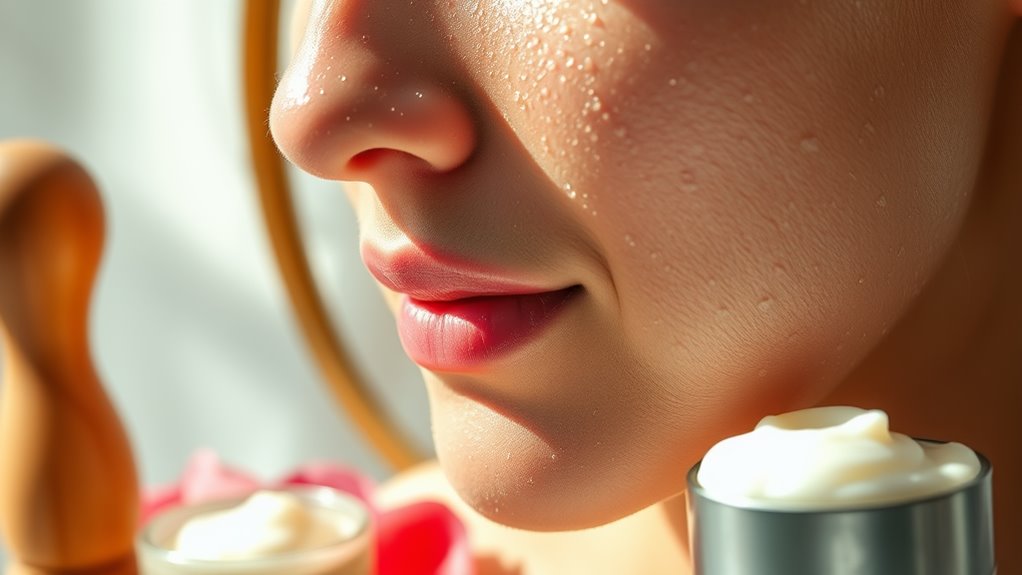Why You Should Always Exfoliate Your Skin in the Right Way
Exfoliating your skin can transform your complexion, but doing it the right way is essential. It’s not just about sloughing off dead skin; it’s about choosing the right method for your skin type and frequency. Overdo it, and you risk irritation and damage. So, what’s the best approach to guarantee you’re reaping the benefits without the drawbacks? Let’s explore the important aspects of effective exfoliation.
Key Takeaways
- Exfoliation removes dead skin cells, promoting cell turnover and a brighter, healthier complexion.
- Choosing the right exfoliant based on your skin type enhances effectiveness and minimizes irritation.
- Proper exfoliation prevents clogged pores, reducing the risk of breakouts and excess oil production.
- Over-exfoliation can lead to irritation and weakened skin defenses, emphasizing the need for a balanced routine.
- Following exfoliation with a moisturizer and sunscreen helps maintain hydration and protects against increased sun sensitivity.
The Importance of Exfoliation for Healthy Skin
Exfoliation is essential for maintaining healthy skin, as it helps remove dead skin cells and promotes cell turnover.
You’ll want to incorporate effective exfoliation tips into your skincare routine for best results. Start by choosing the right frequency; for most skin types, exfoliating 1-3 times a week strikes the perfect balance.
Always use gentle techniques to avoid irritation, focusing on areas that need extra attention. Don’t forget to follow up with a high-quality moisturizer to lock in hydration.
Pay attention to your skin’s response; if you notice redness or sensitivity, adjust your routine accordingly. Additionally, consider using a DIY facial scrub to achieve professional-quality exfoliation that is both gentle and effective.
Mastering exfoliation won’t only improve your skin’s texture but also enhance the effectiveness of your other skincare products, leading to a radiant complexion.
Different Methods of Exfoliation: Physical vs. Chemical
When considering how to exfoliate your skin effectively, you’ll find two primary methods: physical and chemical exfoliation.
Physical exfoliation involves using scrubs or tools to manually slough away dead skin cells. You can achieve instant results, but be cautious not to overdo it, as harsh scrubbing can irritate your skin.
On the other hand, chemical exfoliation employs acids like AHAs or BHAs to dissolve dead skin cells and promote cell turnover. This method penetrates deeper, offering enhanced exfoliation without the risk of abrasion. A specific body exfoliator can also deliver noticeable skin-tightening results when used correctly.
Choose the method that aligns with your skin’s needs and your desired results. Ultimately, mastering both techniques allows you to tailor your routine effectively and achieve a radiant complexion.
Understanding Your Skin Type for Effective Exfoliation
How well do you know your skin type? Understanding whether your skin is oily, dry, combination, or sensitive is essential for effective exfoliation. Each skin type requires a tailored approach.
If you have oily skin, you’ll benefit from exfoliants that target excess oil and unclog pores, like salicylic acid. For dry skin, opt for gentle, hydrating exfoliants such as lactic acid, which won’t strip away moisture.
Combination skin needs a balanced strategy; use different methods on varied areas. Sensitive skin is best served by mild, nourishing exfoliants to avoid irritation. Additionally, incorporating essential vitamins into your skincare routine can further enhance your skin’s radiance and overall health.
The Risks of Over-Exfoliation and How to Avoid It
Knowing your skin type helps you choose the right exfoliation routine, but it’s equally important to be aware of the risks associated with over-exfoliation.
Excessive exfoliation can lead to several issues, compromising your skin’s health. Here are four risks you should consider:
-
Irritation – Over-exfoliating can cause redness, inflammation, and discomfort.
-
Sensitivity – Your skin may become more reactive to products and environmental factors.
-
Impaired Barrier Function – Stripping away too many layers can weaken your skin’s defenses against pollutants.
-
Increased Breakouts – Over-exfoliation can trigger an imbalance, causing your skin to produce more oil and leading to acne.
To maintain healthy skin, stick to a balanced exfoliation routine tailored to your unique needs. Additionally, incorporating essential skincare routines can help support your skin’s overall health and prevent acne.
Expert-Recommended Best Practices for Exfoliation
To achieve ideal skin health, it’s crucial to follow expert-recommended best practices for exfoliation.
Start by choosing the right exfoliant for your skin type—chemical exfoliants work wonders for sensitive skin, while physical scrubs can benefit those with oilier complexions.
Exfoliate no more than 1-3 times a week to maintain balance without overdoing it. Always apply exfoliants on clean, dry skin to maximize effectiveness.
Follow up with a hydrating serum or moisturizer to replenish moisture and soothe any irritation. Don’t forget to apply sunscreen daily, as exfoliation can increase sun sensitivity.
Incorporating a triple-action facial scrub can further enhance the benefits of your exfoliation routine by simultaneously exfoliating, brightening, and moisturizing the skin.
Finally, listen to your skin—if you notice redness or irritation, scale back your routine.
Mastering these practices will elevate your exfoliation game and enhance your skin’s overall radiance.
Incorporating Exfoliation Into Your Skincare Routine
While it might seem intimidating to add exfoliation to your skincare routine, doing so can greatly enhance your skin’s texture and appearance.
To seamlessly incorporate exfoliation, follow these steps:
-
Choose the Right Product: Select a gentle exfoliant tailored to your skin type, whether it’s a physical scrub or a chemical exfoliant.
-
Frequency Matters: Start with exfoliating once a week, then adjust based on how your skin responds.
-
Time It Wisely: Exfoliate in the evening to allow your skin to repair overnight, enhancing effectiveness.
-
Moisturize After: Always follow up with a hydrating moisturizer to replenish your skin’s moisture barrier and avoid irritation.
With these tips, you’ll master the art of exfoliation, revealing vibrant, healthy skin.
Frequently Asked Questions
Can I Exfoliate if I Have Sensitive Skin?
Yes, you can exfoliate with sensitive skin, but you should choose gentle exfoliants. Look for products with soothing ingredients, and always patch test before applying to guarantee your skin doesn’t react negatively.
How Often Should I Exfoliate My Body?
You should exfoliate your body about once or twice a week. This frequency helps remove dead skin cells without overdoing it, keeping your skin smooth and healthy while preventing irritation. Adjust based on your skin’s needs.
Is It Safe to Exfoliate During Pregnancy?
It’s generally safe to exfoliate during pregnancy, but stick to gentle methods. Avoid harsh scrubs and chemicals. Always consult your healthcare provider to guarantee you’re using products that won’t harm you or your baby.
Can I Use Homemade Scrubs for Exfoliation?
Yes, you can use homemade scrubs for exfoliation. Just guarantee you choose natural ingredients that suit your skin type. Test on a small area first, and adjust the formulation based on your skin’s response.
What Should I Do After Exfoliating?
After exfoliating, rinse your skin thoroughly with lukewarm water, then gently pat it dry. Follow up with a hydrating moisturizer or serum to restore moisture and protect your freshly exfoliated skin from irritation.

